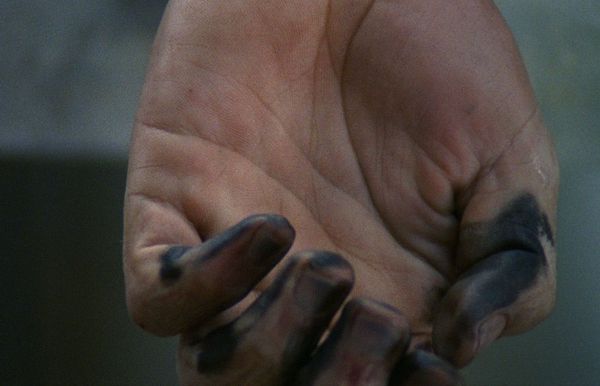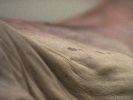Eye For Film >> Movies >> Ulterior (2014) Film Review
Ulterior
Reviewed by: Rebecca Naughten

Almost abstract in some of its compositions, Ulterior connects the circle of life by showing bodies at their most vulnerable - at the end of life and at the start. Not for the squeamish, the short essay film effectively represents the life cycle in reverse with some fairly graphic shots of bodies in states of violent intervention (i.e. being cut open), starting with decomposing bodies in a morgue and ending with a caesarean birth in a delivery room.
The close-ups of skin textures, lines, marks and imperfections give a sense of abstract detachment but simultaneously show the human form at its most vulnerable, something underlined by the bruises, lividity marks and ink-stained fingers visible on most of the corpses - death seems to have been violent, or to at least have left a permanent mark, with the body as a palimpsest. The nature of the close-ups of skin and body parts - individual shots of flesh and limbs or appendages rather than panning or tracking along bodies, which fragments the human form even further - means that it is not immediately apparent that they are not part of a living being and this makes their presentation unsettling. Although, that said, their pallor and skin tones do not connote someone in the prime of life.

The not-exactly-careful way that the bodies are moved by the morgue attendant - limbs haphazardly overlapping and seemingly more than one body on a given table - renders them as meat, with skin loose on the awkward bones. Writer-director Sabrina Muhate is interested in the treatment of bodies in death in terms of the processes undergone. As we see bodies cut open again (an implied repetition because they already have seams and stitches - suggesting that autopsies have taken place and this is preparation for disposal) and organs removed, the director once more gets closer to the texture of the body, finding abstract patterns in layers of fatty tissue, ribcages and bloody water.
The appropriately violent editing cut that takes us from a corpse being cut open (to remove organs) to a mother's stomach being cut for a caesarean is sudden enough to give the viewer a jolt. The baby's skin has a similarly wrinkled and viscous-coated appearance to the bodies we have already seen - but the vocal cry and blinking eyes confer a different state of vulnerability and a body to be treated with utmost care. The sound of running water in the morgue is a soundbridge to the birth and is still audible beneath the crying and the beep of the heart monitor - a signal that life is on an inevitable journey towards death, and the cycle continues.
Ulterior is a slightly macabre film due to its content - and some may find it disturbing - but the film is shot and edited (also by Muhate) in such a way to be indicative of a director with an appreciable eye for detail and confident in her sense of editing rhythm.
Reviewed on: 10 Oct 2015
















